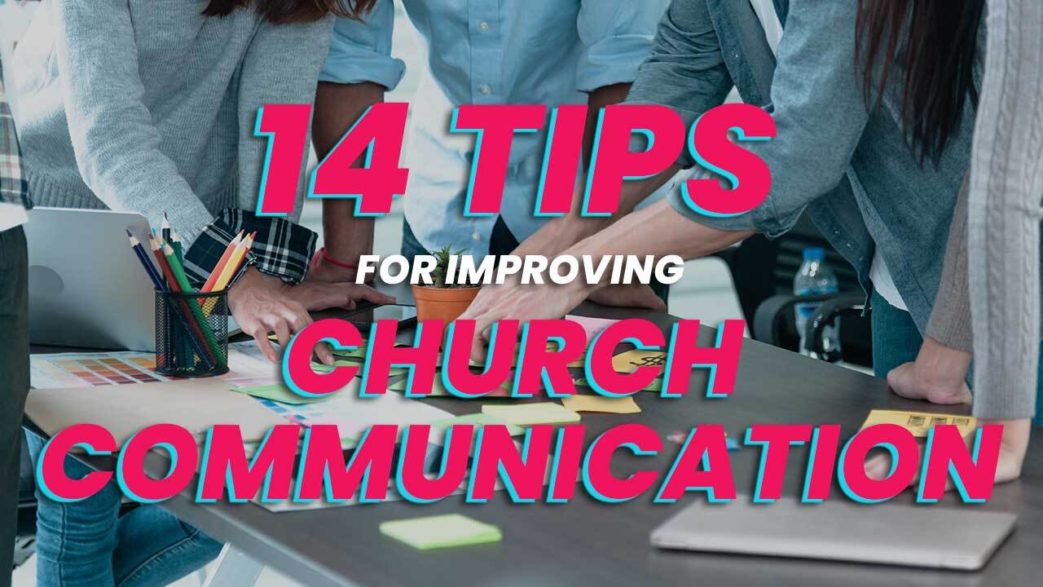Improving church communications is often a goal for churches, but one that may not always have an obvious solution. After all, the way a church communicates varies based on the church and member preferences.
The good news is there are now more ways than ever to stay in contact with your church family, whether they’re online or off. The key is choosing a consistent strategy that works for everyone.
No matter which communications methods your church picks, use them regularly to make sure everyone stays informed about what’s going on in your church.
Table of contents
- 1. Send Out Regular Church Newsletters
- 2. Post Updates On Social Media
- 3. Create An Announcements Page
- 4. Keep All Events Updated
- 5. Ask Members How They Prefer To Be Contacted
- 6. Offer Ways For Members And Visitors To Provide Feedback
- 7. Gather New Visitor Information
- 8. Create A Resources Page
- 9. Host Regular Meetings
- 10. Use Text Messaging
- 11. Have A Clear Communication Strategy
- 12. Segment Communications
- 13. Make All Written Communications Easy To Read
- 14. Ensure Communications Are Relevant

1. Send Out Regular Church Newsletters
Both print and email church newsletters are still highly effective ways to communicate the latest news about your church. While email newsletters give you a bit more flexibility in what you can include, don’t be afraid to go old school with print. Many members enjoy having a physical copy, especially if there’s something personal in it such as picture of a relative being honored as a volunteer or something similar.
However, emails works best for your online followers. You can even set up your newsletter signup form to customize the newsletters to the user’s preference. For example, if they live out of state, they might not be interested in local church events that won’t be streamed online.
This is also a great strategy if you also offer newsletters for each ministry group in your church. Subscribers can choose just the ministries they’re interested in. Of course, always include a section in every newsletter about general news, announcements and latest blog posts.
If you’re new to digital church newsletters, check out the following guides:
- Best Church Newsletter Platforms
- 17 Tips For Creating A Must-Read Church Newsletter
- How To Design A Great Church Newsletter
2. Post Updates On Social Media
As of February 2021, 72% of all Americans use at least one social media platform to connect with friends, family, businesses and non-profits. This includes all ages. Even 45% of those age 65+ use social media. The highest use is among 18-29 (84%) and 30-49 (81%). The lesson here is if you want to keep in touch with your church family all in one place, social media is likely the next best thing to a church newsletter. This is especially true for more time sensitive communications.
While there are a variety of social media platforms for your church to use, try to pick just one or two that the majority of your church members use. This is a great strategy for smaller churches that might not have the resources to manage a complex social media strategy. Take a poll to see which platforms people use and how often.
Once you know which platforms you’ll be using, let people know. Make announcements in your church newsletter, while live streaming services or in pre-recorded videos, after in-church services and on your church blog. Then, develop a set strategy to post consistently and maintain an active presence to make your communications more effective.
3. Create An Announcements Page
While you may already have an Events page on your church website, consider adding an Announcements page. Consider this your church’s digital bulletin board. You can even add a corkboard graphic with colorful sticky notes with important announcements to make things fun and stand out.
All important schedule changes (such as inclement weather), volunteer updates, meeting times, upcoming events (such as those within the next week or two), special live streaming events and similar items all get listed on this page. Keep it updated daily to ensure all information is current. Consider assigning a volunteer to the task. All church staff and other volunteers send any announcements to a single contact and they update the page.
Your announcements page can also be a physical board at your church. Consider your website page a duplicate of this physical board or vice versa. Some churches even have a weatherproof board outside the church for people to check even when the church is closed.
4. Keep All Events Updated
When it comes to improving church communications, keeping your church website up to date is critical. A common area where many churches fall short is events. With so much going on, sometimes updating upcoming events gets pushed to the side. Yet, it’s so disappointing when people don’t show up to fun church events simply because they didn’t see it on your site.
Create a schedule to update certain portions of your church website with current information. For instance, you might update all events on Tuesdays. If you list events anywhere else, update those platforms at the same time. For example, if you post about events on Facebook, update events on Facebook when you update your church’s Event page.
The more current your information is, the more effective your communications are. Plus, you’ll reduce how many emails, website questions and social media questions you get about when a certain event is being held.

5. Ask Members How They Prefer To Be Contacted
It’s a simple thing, but sometimes the easiest solution to improving church communications is to ask people how they want to be contacted. Let your members and online followers choose how you’ll contact them. If part of your members prefer text updates, set up a system to text all communications to that group. If some prefer email, email just that group.
The only truly effective communications are those that people actually receive and interact with. If you’re using their preferred method(s), you’ll reach far more people. Also, keep your website updated with all the details you’re sharing using other methods. This provides a single reference point for members and your online community to check out at any time.
If you end up with a dozen different methods, pick the most popular 2-3 methods. After all, your communications strategy needs to be easy enough to manage without a large team to pull it off. Typically, email, text and social media are the most popular.
6. Offer Ways For Members And Visitors To Provide Feedback
Often, you think about church communications being about the church reaching out to the church family. But, sometimes, it works the other way around. Maybe members have questions about how certain parts of your website work. Or, maybe they’d love to see certain types of content on your social media pages.
Provide ways for members and website/social media visitors to provide feedback. In fact, encourage them to leave your church feedback. The more you learn about what members and your online community want and need, the easier it is to interact with them.
Plus, they’ll often give you great ideas for new ways to communicate. For instance, maybe someone would love to have a blog post each week with X important points for the previous sermon. This is something you could easily add to your blog and include as a link in your church newsletter and on social media. It’s also a good resource for those who couldn’t attend in person.
7. Gather New Visitor Information
Improving church communications doesn’t start and end with existing members or online followers. It should always include new visitors too. In this case, it’s all about introducing your church to them and gathering a few contact details to be able to stay in touch with them.
There are several great strategies to use to welcome new visitors and gather information. All you really need is an email or phone number. This lets you thank them for attending and ask if they have any feedback or questions. This simple gesture shows that your church cares. Plus, it also gives you a chance to share your church’s website with them, including linking to any new visitor resources.
Even brand new churches are able to attract more new visitors by using certain communication techniques. Naturally, gathering information helps new churches stay in contact with those new visitors.
8. Create A Resources Page
Making information easy to find is a great way to improve how you communicate with your church family. Provide a dedicated section on your site just for useful resources. This could include helpful study guides, recommended apps, links to your most helpful blog posts and so on. Keep this page organized for everyone to use.
Consider referencing this page in your church newsletter, in a sticky post on Facebook and even on print communications.

9. Host Regular Meetings
Sometimes, written (including digital) communications aren’t enough. You need live communication. Improving church communications may mean you need to start hosting regular meetings. These can be held online or offline or even both at the same time. This provides ample flexibility for everyone involved to attend.
Meetings are perfect when you need to communicate with specific segments of your church family. For instance, volunteers might meet weekly to discuss projects and progress. You might host special Q&A sessions online.
The bad thing is meetings have a pretty negative reputation. They can be long and boring. So, make communications during meetings more effective by having a set agenda. Also, try to keep meetings between 30 to 45 minutes. While 30 minutes might seem too short, it’s actually efficient if you stay on track, especially if it’s a video call.
It’s also been proven that mid-week meetings tend to be the most effective. Tuesdays tend to be best.
10. Use Text Messaging
Even people who don’t use social media often text. It’s a simple way to stay in contact with people. It’s also a great way for your church to contact members. For instance, do you have an event coming up in a few days? Nudge members to RSVP via a quick text.
Texts are best for quick and simple communications. You don’t want to bombard members with too many texts. However, some church groups might find that group texts work well in lieu of long meetings for quick clarification or updates.
11. Have A Clear Communication Strategy
Even with all these tips on improving church communications, the single most important is to have a clear communication strategy. Your strategy should include answers to all of the following:
- What methods will you use?
- What type of communications will you send with each method?
- What is your communication schedule?
- What types of communications are most important for your church?
- Do individual groups or segments of your church need different communications?
- How will you track communication effectiveness?
- Who will be in charge of communications?
Knowing all of this upfront makes it easy to communicate regularly with your entire church family, but offline and online. By being consistent with the methods you use and the types of communications, people know what to expect and where to find the information they need.
12. Segment Communications
While we’ve sort of covered this, segmentation is worth mentioning. Every person you’re communicating with doesn’t need the same information. Only new visitors need new visitor emails. Only volunteers need details on project progress and upcoming meetings. Try to segment your communications to make it easy for people to only receive what they need. This helps reduce communication overload, which can make people simply ignore church communications, even when they are relevant.

13. Make All Written Communications Easy To Read
This isn’t about handwriting, though if you’re physically writing communications, use neat handwriting. Instead, this is about making communications easy to scan.
If you’re sending a text message, for example, make it short and to the point. Try to avoid slang, acronyms and emojis (in place of words). For newsletters, keep paragraphs short and use plenty of headings to separate content. Do the same with blog posts. Most people won’t read every word of your church communications. Instead, they’ll look for parts that stand out to them. Problogger has a great guide on creating more scannable, easy to read content.
14. Ensure Communications Are Relevant
Finally, make sure the church communications you’re sending are relevant. Sending out an email or text every time you find a great article probably won’t go over so well. Instead, create a weekly blog post with a list of article links and send that out with your church newsletter or post it on social media.
Also, remember that the frequency of communications varies based on the method used. Posting multiple times a day on social media is fine. Sending several emails a day (unless you’re communicating specifically with staff or certain members) isn’t as acceptable. Keep people engaged and make communications more effective by only sending what’s relevant.
As you might have noticed, a church website is a core component of improving church communications. You can even have password-protected areas of your site for your church’s staff to communicate with each other. Check out our free church website review to see if there are any ways your site can be improved for better communications.




